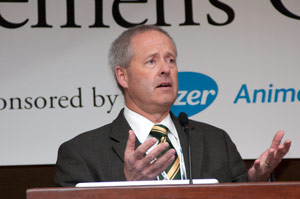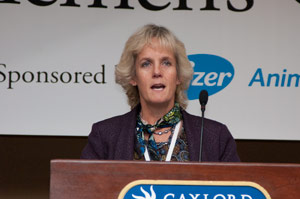Genetics of Disease
by Troy Smith for Angus Productions Inc.
NASHVILLE, Tenn. (Feb. 1, 2012) — Among the topics discussed during the 2012 Cattle Industry Convention was the potential for using modern genomic tools to manage cattle health. A Cattlemen’s College session addressed opportunities to develop DNA tests for use in selecting against susceptibility to bovine respiratory disease (BRD).
Information regarding the prevalence, causal factors and strategies for combating BRD was presented by South Dakota State University veterinarian Chris Chase. Calling it the most significant cattle disease, Chase said BRD results in high mortality, and morbidity costs due to medication, labor and increased feeding time. Adding in costs of reduced average daily gain and feed conversion, BRD represents an estimated $625 million annual cost to the industry.

Problems resulting from inaccurate diagnosis of BRD have led to low estimates of heritability from field data, said CSU's Mark Enns. However, evidence does suggest differences in susceptibility to the disease. [PHOTOS BY TROY SMITH]
Colorado State University geneticist Mark Enns said the lack of adequate field data has been a barrier to identifying animals most susceptible to pathogens and eliminating them from breeding herds through genetic selection. The problems stem from inaccurate diagnosis, since not all sick animals may be identified and healthy animals are sometimes classified among the sick. Additionally, some susceptible animals are not identified because they were not exposed to the pathogen.
“The result is low estimates of heritability from field data,” said Enns. “But there is evidence showing there are differences in susceptibility.”
Enns cited evidence suggesting the heritability is 0.18, which is not high. It is, however, similar to that of milk production, and expected progeny differences (EPDs) for milk have been used successfully.
“Realizing the field data is noisy, it’s likely [that] the best opportunity for increasing accuracy of selection is through DNA markers,” said Enns. “That doesn’t mean we don’t need data to support good decisions.”

Alison Van Enennaam, UC–Davis, described a new national research project for collecting needed BRD field data.
Alison Van Enennaam, University of California-Davis geneticist, described a new national research project for collecting needed field data. The BRD Complex Coordinated Agricultural Project (BRD CAP) will utilize two separate cattle populations for data collection, with each 2,000-head population divided into case and control groups. Two additional groups (1,000 head each) will be used to validate results from the discovery populations.
All cattle will be genotyped, using the 700K high-density SNP chip, with the objective of finding gene markers associated with susceptibility to BRD.
“We’re hoping,” said Van Enennaam, “with the high-density chip, DNA tests would work across breeds.”
-----------------------------
Editor’s Note: The above article was written under contract or by staff of Angus Productions Inc. (API). It may not be reprinted without express permission of API. To request reprint permision, contact the editor at 816-383-5200.
www.4cattlemen.com is an event coverage site provided by the editorial team at Angus Productions Inc. (API), publisher of the Angus Journal, the Angus Beef Bulletin, the Angus Beef Bulletin EXTRA and the Angus e-List. For questions about this site, to submit an article for our consideration, or to report a broken link, contact the editor at 816-383-5200; 3201 Frederick Ave., Saint Joseph, MO 64506.
API claims copyright to this web site as presented. We welcome educational venues and cattlemen to link to this site as a service to their audience.

